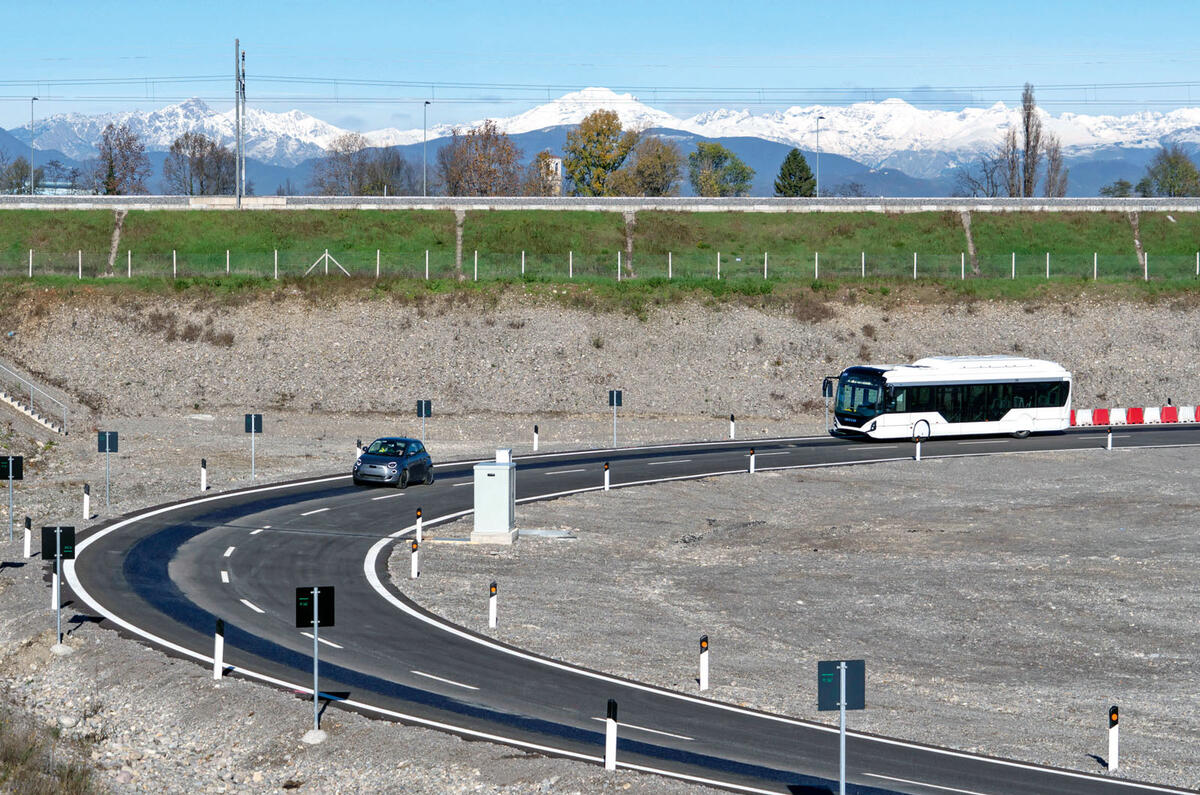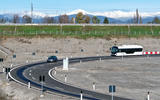The prospect of charging a car, or any electric vehicle, while it’s driven along the road is an appealing one and something that has been the subject of continual research and development throughout the world for well over a decade.
One of the latest projects is the Arena del Futuro, a 1050m-long oval test circuit built by Stellantis and partners near the A35 between Brescia to Milan in Italy, to develop ‘dynamic wireless power transfer’ (DWPT) or, to put it another way, EV charging on the move.
Being able to wirelessly charge a vehicle on motorways while driving it would have a major impact on EV design and prospects for haulage trucks, which currently would need unfeasibly large batteries to achieve the distances they need to cover. However, cars and trucks could have much smaller batteries if they relied on static charging locally, with longer range achievable on trunk routes through the use of DWPT. Trials started this year with a Fiat 500 electric and Iveco E-Way bus equipped with DWPT receivers.
Inductive charging of EVs has been around as long as the modern EV and trialled in real-world conditions as far back as the early noughties. In its basic form, the principle is exactly the same as it is for wireless phone or toothbrush charging, or for generating a spark in a petrol engine ignition system.
‘Wireless power transfer’ takes a number of different forms but is based on the phenomenon that if a wire is placed in a magnetic field, and then the magnetic field is removed, a voltage is induced (generated) in the wire. Scaled up, with coiled wire and powerful electromagnetic fields, the electrical power generated can be big enough to charge an EV.
The charging technology used for the project was developed by Israeli partner Electreon and consists of multiple charging pads sunk beneath 11cm of asphalt along the length of the road and connected by a cable. As the vehicle passes over each charging pad, its receiver, working at an induction frequency of 85kHz, generates electricity to charge the battery.
The tricky bit is alignment. Wireless phone charging pads in cars can be more sensitive to the position of the phone than others. The same applies to positioning an EV equipped with wireless charging hardware over a charging pad, either sitting on the surface or under the surface. The Electreon system is much less fussy about alignment than has previously been the case and is unique in that it provides both static charging when a vehicle is stationary and dynamic when driving.
It is also the first time a dynamic charging system has been powered by DC current, which allows energy transfer to the vehicle compatible with motorway speeds.









Join the debate
Add your comment
trucks won't need enourmous batteries, they're already being trialed with Pantagraph power supply, simlar to an electric train. This underground system sounds like it'll be the wrong combination of maintenance issues and inefficiency, with a payment system that'll be overcomplicated? What's wrong with just having enough chargers?
Make 6,000 dollar to 8,000 dollar A Month Online With No Prior Experience Or Skills Required. Be Your Own Boss And Choose Your Own Work Hours...Thanks A lot Here:_______Moneystar1.com
It sounds like this system would mean you'd never have to charge your Car statically?, if your using your Car every Day it's really just being kept at optimum efficiency?, and, it'll take decades before all main Roads are dug up, the coils installed, the endless single lane, delays etc, I'm sure there are positive's for this system, a more carbon neutral transport system, less Ozone damage, no pay to enter areas in Cities, if the bugs are ironed out I guess the future for us the road users could be good.
Until the water or gas companies come along just after its laid, dig it all up and don't replace it properly :)